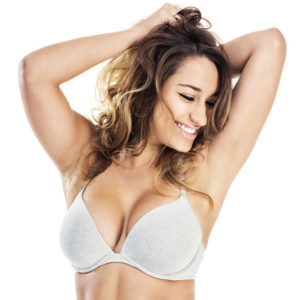 Excessively large breasts can cause a multitude of problems, including back and neck pain, recurring rashes, grooves in the shoulders from bra straps and emotional distress. Breast reduction surgery, also known as reduction mammaplasty, offers relief to women with large breasts. Read on to learn more about this popular surgery with high patient satisfaction rates.
Excessively large breasts can cause a multitude of problems, including back and neck pain, recurring rashes, grooves in the shoulders from bra straps and emotional distress. Breast reduction surgery, also known as reduction mammaplasty, offers relief to women with large breasts. Read on to learn more about this popular surgery with high patient satisfaction rates.
Breast reduction surgery
Breast reduction surgery involves removing fat, glandular tissue and excess skin from the breasts to create breasts that are smaller, firmer and lighter. If you have excess areolas, which is the darkened area around the nipple, these will be reduced in size during surgery to be more in proportion with the new breasts.
Candidates
If you have large, pendulous breasts and the problems that come with them, you could be a candidate for surgery. You need to be in good physical health and have realistic expectations for surgical outcomes. You should be done with pregnancy and breastfeeding before considering surgery.
Incision patterns
During your consultation, Dr. Price will discuss different options for incision patterns and make recommendations based on factors such as the amount of reduction desired and the laxity of breast tissue. One pattern is the donut incision, which encircles the areola, and scars will be concealed within the darkened area around the nipple. A second pattern option is a keyhole pattern where the incision is made around the areola and down to the breast crease. The third incision option involves an incision around the areola, down to the breast crease and horizontally along the breast crease like an anchor shape. For breasts with excellent skin elasticity, microincisions to remove tissue with liposuction alone may be another option.
Once the incisions are made, the nipple and areola are repositioned to a more youthful position. Excess breast tissue will be removed, as remaining tissue is lifted and shaped. Sometimes liposuction is performed in the armpit area to improve contours. Supportive sutures are placed deep within the breast, and the incisions are closed.
Breast reduction surgery has one of the highest satisfaction rates among cosmetic surgery procedures. If you are interested in learning more about breast reduction surgery, call (203) 453-6635 today to set up a consultation.

 If you think your eyes are looking tired and puffy, you may want to think about eyelid surgery, also known as
If you think your eyes are looking tired and puffy, you may want to think about eyelid surgery, also known as  A woman’s body goes through many changes in her lifetime. Pregnancy, breastfeeding and aging itself can cause breasts to lose their youthful position and begin to sag. If you’ve thought about breast surgery, you may be wondering which breast procedure is right for you. Here is more information on and breast lift.
A woman’s body goes through many changes in her lifetime. Pregnancy, breastfeeding and aging itself can cause breasts to lose their youthful position and begin to sag. If you’ve thought about breast surgery, you may be wondering which breast procedure is right for you. Here is more information on and breast lift. The skin around your eyes and forehead are often the first place on your face to show the signs of aging. Millions of people turn to
The skin around your eyes and forehead are often the first place on your face to show the signs of aging. Millions of people turn to  Childbearing is a fulfilling time in a woman’s life, but not the loose skin, excess fat and sagging breasts that comes with it. Many women turn to a plastic surgeon for what’s called a “Mommy Makeover,” which is a popular combination of procedures that can help a woman get her pre-pregnancy body back. Read on for some of the most frequently asked questions if you’re considering a
Childbearing is a fulfilling time in a woman’s life, but not the loose skin, excess fat and sagging breasts that comes with it. Many women turn to a plastic surgeon for what’s called a “Mommy Makeover,” which is a popular combination of procedures that can help a woman get her pre-pregnancy body back. Read on for some of the most frequently asked questions if you’re considering a  Rhinoplasty, also called a nose job, is a common plastic surgery procedure that can improve your appearance and self-image and even correct impaired breathing and other functional concerns. Read on to learn about who would make a good candidate and benefit from a
Rhinoplasty, also called a nose job, is a common plastic surgery procedure that can improve your appearance and self-image and even correct impaired breathing and other functional concerns. Read on to learn about who would make a good candidate and benefit from a  Long, beautiful eyelashes are all the rage right now, but some women are deterred from false eyelashes because of the cost and continual upkeep. Latisse is an FDA-approved treatment to help lengthen, thicken and darken your very own eyelashes for a more natural look. Read on for more information about this popular eyelash growth treatment.
Long, beautiful eyelashes are all the rage right now, but some women are deterred from false eyelashes because of the cost and continual upkeep. Latisse is an FDA-approved treatment to help lengthen, thicken and darken your very own eyelashes for a more natural look. Read on for more information about this popular eyelash growth treatment. There are so many things to consider when electing to undergo breast augmentation surgery. Women have choices when selecting the right implant type, which makes it one of the toughest decisions. The IDEAL IMPLANT is a state-of-the-art structured implant that has several advantages over other implant types. Read on to learn the differences between implants.
There are so many things to consider when electing to undergo breast augmentation surgery. Women have choices when selecting the right implant type, which makes it one of the toughest decisions. The IDEAL IMPLANT is a state-of-the-art structured implant that has several advantages over other implant types. Read on to learn the differences between implants. It’s no secret that prolonged sun exposure can damage your skin and cause fine lines and wrinkles to appear, not to mention increases your chances for skin cancer. And if you’ve had cosmetic surgery or a non-surgical treatment, your treated skin is even more sensitive and more prone to ultraviolet radiation absorption. Scars from incisions are more prone to sunburn, and there’s a chance the scar will become more noticeable with sun exposure. Read on for eight tips to
It’s no secret that prolonged sun exposure can damage your skin and cause fine lines and wrinkles to appear, not to mention increases your chances for skin cancer. And if you’ve had cosmetic surgery or a non-surgical treatment, your treated skin is even more sensitive and more prone to ultraviolet radiation absorption. Scars from incisions are more prone to sunburn, and there’s a chance the scar will become more noticeable with sun exposure. Read on for eight tips to  Many men who have gynecomastia, or enlarged breasts, may be too self-conscious and will avoid certain physical activities and intimacy. But this condition shouldn’t keep you away from enjoying activities, including going shirtless at pools and the beach. Gynecomastia surgery offers many benefits, including improved self-confidence through improved male contouring.
Many men who have gynecomastia, or enlarged breasts, may be too self-conscious and will avoid certain physical activities and intimacy. But this condition shouldn’t keep you away from enjoying activities, including going shirtless at pools and the beach. Gynecomastia surgery offers many benefits, including improved self-confidence through improved male contouring.

